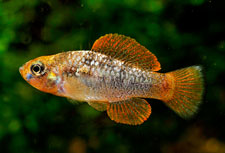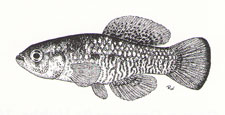History
The genus Garmanella is well defined consistently regarded as a distinct genus since description in 1936, up to Parenti in 1981, who synonymized it with Jordanella. The genus validity has been re-established according to genetics, molecular biology and osteology, by 3 publications.
Parenti (1981) based the synonymization into Jordanella on similarities in the shape of the Dorsal fin and the presence of a dark sub-ocular bar. Foster (1982) argumented against this synonymization, based on sex chromosomal differentiation. Parker and Kornfield (1995), while studying the mitochondrial DNA sequence data, found that Garmanella was more closely related to the genus Floridichthys than to Jordanella ; Costa (1997) confirmed the differentiation on new osteological characters.
Garmanella is deep bodied and cylindrical, with 15 or more Dorsal rays, like Jordanella (and unlike other Cyprinodontins which have less than 14). Garmanella has a short Dorsal, like Floridichthys, no thickened and spine-like first ray of Dorsal fin (unlike Jordanella), Anal fin soft rays 8 to 10, in Garmanella (vs. 11 to 13 in Jordanella), naked lower preorbital region, male, with strong reticulations on sides, dark suborbital bar, like Floridichthys and Jordanella, but unlike Cyprinodon, Garmanella has no enlarged post-opercular scale immediately behind gill cover and above Pectoral fin (Wiley & Ghedotti, 2002).
Floridichthys, Garmanella and Jordanella form a clade of genera.
Type locality of Garmanella pulchra is 5 km east Progreso, Yucatan, southeastern Mexico, approx. 89 39' W 21 15' N. Their range is large, in coastal fringes of Yucatan (Mexico), Belize.
The name given refers to the general appearence of the species which is beautiful (from Latin: pulcher).
Reproduction
Breeding Garmanella pulchra is for expirienced aquarists. The breeding aquarium should be relative large with intensive light (partly with dark spots by shelters or floating material), with a strongly brackish water, with a thick bed of sand and gravel on bottom, with rocks, pebbles, wood roots and alike barriers allowing the males to create territories for their own.
Males are very territorial and only females are allowed to enter the territory for spawning, but afterwards are chased away. Best is to use long perlon woolmops that reach from the surface to the bottom so the pair can decide where to put the eggs. Often this will be in the lower section of the mop.
The eggdiameter is about 1.1 mm and eggs are white colored. Incubation 2 weeks depending on temperature. If low, incubation may take longer. First food fresh artemia nauplii.
Fry will swim immediately after hatching but will remain confined to bottom and are white colored.Sexation in aquarium 8 weeks (10 mm at 3 weeks). Maturity in aquarium 5 months but full size after 7 months.
Remarks :
Tony Terceira wrote: The breeder of the G. pulchra had a few pairs in a 15 gallon tank. The water had a salt concentration of 1.010. There were bottom mops and a sponge filter in the tank above a sandy bottom.
Mops were rather large and provided cover for the fish. He collected eggs and hatched them in water of he same conditions. Live baby brine upon hatching. There also was a nice cover of algae on the side of the tank and some hair algae in one section. I am sure the fish were grazing on the algae. Young fish were raised in tanks that also contained some cover and a mop for protection. Young pairs were very active and displayed often, seldom causing any harm to each other.
Thank you Tony for sharing this info !!
Variations
Map
Meristics
Max. size 60.0 mm.
Dorsal 16.0,
Anal 9.0,
D/A - 4.0,
LL scale count (average) 23.0
Pre- dorsal length to % SL – 57.0 %
Depth to % SL – 32.0 %
Literature

